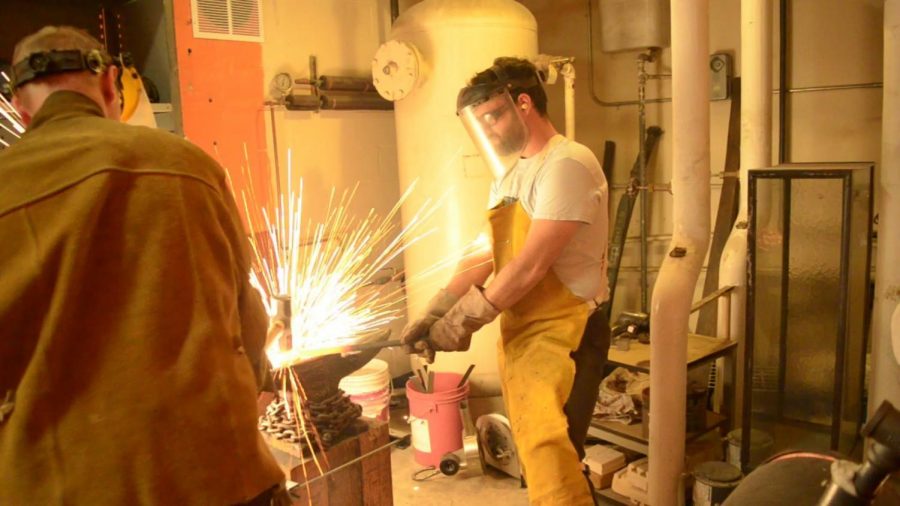Blacksmithing Club prepares for third competition
January 28, 2019
In the back corner of the Rogers Hall basement, members of the Oregon State University Blacksmithing Club have been hard at work on their creation.
In March, the club will enter a blade into the biennial Bladesmithing Competition, held by The Minerals, Metals & Materials Society. This will be its third time participating in this competition.
According to Thomas Wood, a mechanical engineering post-baccalaureate student who currently serves as the club’s president, the project was a true team effort.
“There’s plenty of stuff to do, especially the hammering out portion,” Wood said. “We don’t have a power hammer so all the hammering was done by hand. So it was quite helpful to have multiple people doing the forging process.”
For this year’s entry, four club members created a bowie knife, a type of long double-edged blade.
The completed blade was made by pattern-welding, a method known colloquially as Modern Damascus. With this method, patterns in the the knife are created by stacking and welding together similar, yet different types of metals. According to Wood, this is particularly difficult to accomplish by hand, without a forge press.
“It takes a lot of time and it’s not always super consistent on whether you get the bond correctly,” Wood said.
According to Wood, members worked four to six hours a night for a week to complete the knife. However, producing a blade is only part of the TMS competition.
Lucas Teeter, a Ph.D candidate in materials science, was one of the original three founding members of the Blacksmithing Club. Along with the other founders, he created the club in 2015 to compete in the first TMS Bladesmithing Competition, which they won. According to Teeter, the competition is primarily academic.
“They put a much higher emphasis on scientific characterization and the metallurgy of the blade, rather than someone who’s just buying a knife because they’re a knife collector,” Teeter said.
During judging, the blade counts for as much as the scientific report that is turned in with it. A required poster and video presentation also factor into the final score.
As a graduate student, Teeter has access to tools that help him to write the report – scanning electron microscopes, hardness testers, etc. All blades at the competition must be dull, so cutting and chopping do not factor in to the competition.
“They’re trying to make it fair across institutions, because it’s a student competition. Some universities have a problem with producing weapons on campus. So if we don’t sharpen the knife, it’s not a weapon,” Teeter said.
Chemistry Instructor Christopher Knutson, Ph.D, is an adviser for the club and helps with recruiting, training and ensuring that safety protocols are followed. According to Knutson, one of the primary benefits of participating in the club is the organizational skills that a student can develop.
“It is a team effort, and all of the organizational skills of bringing a high-quality product to competition are very important activities for engineers to learn by doing,” Knutson said via email. “Students not only learn to do long-term planning and organized reporting, but they also learn a great deal about networking when they go to the actual competition.”
Participating in the club also helps engineering students gain experience in concepts that they may otherwise only read about in textbooks, according to Knutson.
“I find that the hands-on experience with heat and work exchanges help the students better comprehend what they are mathematically modeling in classes like Thermodynamics and Materials Science,” Knutson said via email.
During the time between competitions, the Blacksmithing Club functions mostly as an educational resource for those wanting to learn the skill. In the past year, membership of the club has grown from the original three to around 20 regular members. Wood generally takes the lead on instructing new members.
“I get people here that have never swung a hammer in their life. They don’t even know how to hold the thing properly so you teach them how to hold it, how to stand, where to hit it, how to hit it, and you just give them a place and some tools to practice,” Wood said.
For Wood, it is difficult to recall a favorite project that he has worked on in the Blacksmithing Club, because he believes there is something to learn from every new project.
“Usually whatever project I’m working on at the moment is my favorite. It’s something new, you’re learning something new, trying something you’ve never done before, and if it turns out well it’s a success. Even failing, you usually learn something interesting,” Wood said.










































































































